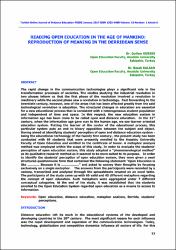| dc.contributor.author | Gürses, gülfem | |
| dc.contributor.author | Kalkan, Başak | |
| dc.date.accessioned | 2019-10-22T20:07:27Z | |
| dc.date.available | 2019-10-22T20:07:27Z | |
| dc.date.issued | 2017 | |
| dc.identifier.issn | 1302-6488 | |
| dc.identifier.uri | https://hdl.handle.net/11421/22330 | |
| dc.identifier.uri | https://dx.doi.org/10.17718/tojde.285717 | en_US |
| dc.description | WOS: 000414268300007 | en_US |
| dc.description.abstract | The rapid change in the communication technologies plays a significant role in the transformation processes of societies. The studies studying the industrial revolution in two phases inform us that the first phase of the revolution involved a revolution in machinery while the second phase saw a revolution in technology. Fast forwarding to the twentieth century, however, one of the areas that has been affected greatly from the said technological revolution is education. The structural changes in education are essential for a new educational process that is consistent with a heterogeneous student population and independent of time and space. In this respect, the new education system in information age has been come to be called open and distance education. In the 21st century, when the information age gave way to the human age, we see learner oriented education system. Putting the learner at the center of the educational process, this particular system puts an end to binary opposition between the subject and object. Having aimed at identifying students' perception of open and distance education system - being the educational technology of the twenty first century-, the present study has been conducted with 69 students that were presently enrolled to the Anadolu University Faculty of Open Education and entitled to the certificate of honor. A metaphor analysis method was employed within the scope of this study. In order to evaluate the students' perception of open education system, this study adopted a "phenomenological method" as its qualitative research method as it seemed to be more suited to its purpose. In order to identify the students' perception of open education system, they were given a semi structured questionnaire form that contained the following statement "Open Education is like ............ Because it is ...................." and asked to convey their thoughts by focusing exclusively on a single metaphor. The answers from the participants were recorded by a camera, transcribed and analyzed through the spreadsheets created on an excel table. The participants of the study came up with 69 valid and 45 different metaphors regarding the concept of open education. Such metaphors were aggregated under 7 different conceptual categories. At the end of the study, it was established that the students enrolled to the Open Education System regarded open education as a means to access to information. | en_US |
| dc.language.iso | eng | en_US |
| dc.publisher | Anadolu University | en_US |
| dc.relation.isversionof | 10.17718/tojde.285717 | en_US |
| dc.rights | info:eu-repo/semantics/openAccess | en_US |
| dc.subject | Open Education | en_US |
| dc.subject | Distance Education | en_US |
| dc.subject | Metaphor Analysis | en_US |
| dc.subject | Derrida | en_US |
| dc.subject | Students' Perceptions | en_US |
| dc.title | Reading Open Education in the Age of Mankind: Reproduction of Meaning in the Derridean Sense | en_US |
| dc.type | article | en_US |
| dc.relation.journal | Turkish Online Journal of Distance Education | en_US |
| dc.contributor.department | Anadolu Üniversitesi, Sosyal Bilimler Enstitüsü, Uzaktan Eğitim Anabilim Dalı | en_US |
| dc.identifier.volume | 18 | en_US |
| dc.identifier.issue | 1 | en_US |
| dc.identifier.startpage | 77 | en_US |
| dc.identifier.endpage | 95 | en_US |
| dc.relation.publicationcategory | Makale - Uluslararası Hakemli Dergi - Kurum Öğretim Elemanı | en_US] |


















